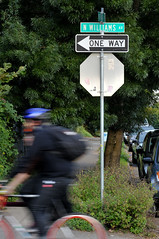“The… project has the opportunity to be a cycle-track the whole length if we don’t let the traffic engineers reserve too much space for cars… First, we have to have the guts to try it and then we’ve got to make it succeed.”
— Chris Smith
At a stakeholder advisory committee meeting later today we’ll learn how community feedback has — or hasn’t — changed the City of Portland’s perspective on the North Williams bikeway project (a.k.a. the North Williams Traffic Safety Operations Project).
Even though Williams is one of the busiest bikeways in the city and a hub of bike-oriented development, PBOT’s initial proposal for the busiest section of the street (from Cook to Skidmore) included no improvement to bike access. Fearing push-back from businesses about automobile access and on-street parking, PBOT was on the verge of caving to the status quo.
The community responded by showing up in droves to an open house for the project. We don’t know the official results from that event, but all signs point to a flood of support for removing one of the existing lanes to make room for a larger and more comfortable bikeway.
It’s no surprise that it’s taking community activism to help PBOT see the right move.
Unlike the “cycle-track” on SW Broadway or the buffered bike lanes on SE Holgate — where auto traffic volumes were low enough so that a re-allocation of roadway space was easy to justify — the traffic volumes on Williams are over capacity during peak hours. Also looming over this project (and everything the city does in this neighborhood) is the complex issue of racial demographic shifts and gentrification.
Williams has also turned into a commercial main street in recent years (much of the development, ironically, due to the street’s great bike access); and historically, PBOT has not made commercial main streets accessible for bicycles. Take Hawthorne, Mississippi, SE 28th, Belmont, Killingsworth, or Alberta as examples. All of those streets have two-way motor vehicle traffic and motor vehicle parking on both sides — and no dedicated space for bicycle traffic.
At our Get Together in the Pearl District last week we were joined by City Planning Commissioner and consummate transportation activist Chris Smith.
As we discussed the lack of separated bike facilities in the Pearl and downtown, Smith brought up the ongoing Central City Plan (which includes Lower Albina):
“I think that bikes are a huge part of the answer for how we get more people in the Central City without clogging it up with cars… I think the conversation for transportation in the Central City Plan is, do we start allocating parts of the right-of-way for cycle-tracks or other protected facilities?”
Smith then used the North Williams bikeway project as a prime example:
“The North Williams bikeway project has the opportunity to be a cycle-track the whole length if we don’t let the traffic engineers reserve too much space for cars. And that is emblematic of what we have to do with the Portland Plan because that will be an example of taking a quality bike facility through a business district.
We’re really good at neighborhood greenways, but they don’t get you to the business district; and to make the healthy, connected neighborhood idea of the Portland Plan work, we’ve got to get the bike facilities into the business district. North Williams is our first opportunity to do that. We have to make it succeed. First, we have to have the guts to try it and then we’ve got to make it succeed. So, show up for those open houses, email people… Make North Williams work!”
Smith is right. This isn’t an easy project for PBOT by any stretch, and that’s precisely why it’s so important.


